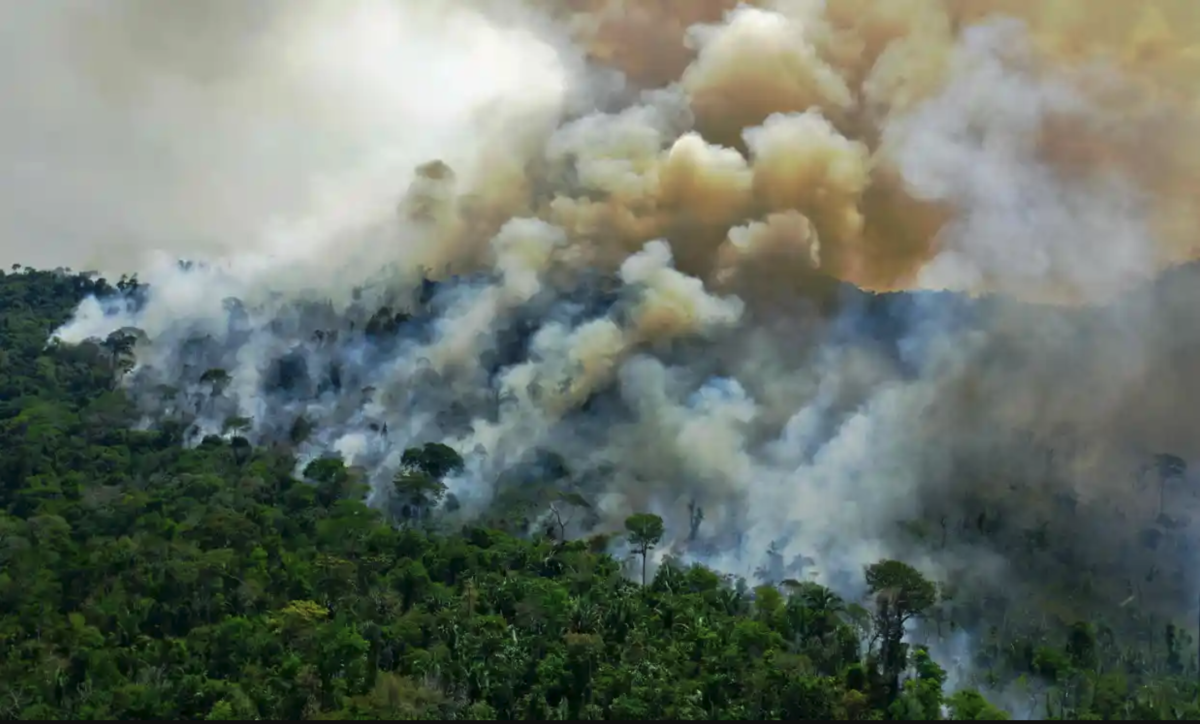We can’t plant enough trees to stop run amok deforestation –
By Glynn Wilson –
WASHINGTON, D.C. — As if the world needed another reason to be down on Russia, the widespread wildfires that raged across Russia in 2021, burning vast swaths of forest and sending smoke as far as the North Pole, unleashed massive amounts of carbon and methane into the atmosphere and brought the planet that much closer to reaching an irreversible tipping point to hell on Earth.
Logging operations continued unabated around the world. The relentless expansion of agriculture fueled the disappearance of critical tropical forests in Brazil and elsewhere at a rate of 10 football fields a minute. Not in a year, month, weak or a day. In a minute.
If you take the time to watch any of the documentaries out there on global warming and climate change, like Earth Emergency on PBS, or read any of the stories or reports like the latest out from the World Resources Institute, Forest Pulse: The Latest on the World’s Forests, you will see the important role trees and forests play in absorbing and storing carbon and helping to cool the planet.
But the science is beginning to show that we are nearing a tipping point where this will no longer be the case. The feedback loops we are starting to see now will only accelerate the warming trends already in progress as cut and burned forests shift from absorbing carbon and storing it to releasing it into the atmosphere, competing with power plants and automobiles as the top emitter of greenhouse gases.
An important goal of the international negotiations to slow global warming and combat climate change involves slowing down or even stopping the practice of deforestation, cutting and burning forests to graze cattle or produce palm oil and other products. Planting new trees or letting cut forests regenerate will be too late to prevent the hell on Earth that is coming.
For all the talks and promises and good intentions, this new report released Thursday shows no evidence of progress to save temperate, tropical or boreal forests. They are all at risk, most notably the tropics.
Tropical forests, sometimes called rain forests, lost 11.1 million hectares of tree cover in 2021, according to new data from the University of Maryland. The annual report by the World Resources Institute, a research group based in Washington, D.C., found that tropical regions lost 9.3 million acres of primary old-growth forest in 2021, resulting in 2.5 billion metric tons of carbon dioxide emissions released into the atmosphere — no longer stored in the woods. That’s about two and a half times as much as the carbon pollution emitted by passenger cars and light trucks in the United States in a year, and up there with power plants that burn fossil fuels, especially coal.
The most forest loss happened in Brazil, the report shows, where that country’s leader has been acting like he’s Donald Trump, accounted for more than 40 percent of the total. That was followed in the Democratic Republic of Congo and Bolivia. The total loss of forest was down 11 percent from 2020, the data shows, but it’s equal to the amount lost in 2018 and 2019.
Rod Taylor, global director of the institute’s global forests program, said that the essentially flat rate of deforestation over the last four years was not good “for the climate, for the extinction crisis, and for the fate of many forest peoples.”
Most forest loss in the tropics is linked to agriculture or mining. Forests are clear cut and burned. When the fires burn out of control, the deforestation expands, and the release of carbon grows exponentially.
Scientists call this a feedback loop, and talk about us reaching a tipping point when the forests themselves stop soaking up carbon and instead begin releasing it into the atmosphere, a tipping point we may be reaching sooner than anyone ever expected with all the data collected over the past 40 years or so.
In addition to releasing these Earth warming greenhouse gases into the atmosphere, deforestation eliminates massive amounts of habitat for plants and animals, further degrades the land and makes already messed up weather patterns worse. Thus fueling even more wild fires, spawning more hurricanes and tornadoes and intensifying rainfall in some areas leading to even more sea level rise and flooding.
The situation has become so dire that at the United Nations climate talks in Glasgow in November, 2021, 141 nations, including Brazil and the Democratic Republic of Congo, pledged to “halt and reverse” deforestation by 2030.
Frances Seymour, a senior fellow at the institute, said drastic steps will be needed to produce the consistent annual declines required to reach that goal.
“The numbers we’re sharing today perhaps could be considered a baseline for assessing the effectiveness of the actions that they take to follow through” on those pledges, she said.
Tree-cover loss in in Brazil increased substantially in the western part of the Amazon basin, according to the report, based on satellite data. This could be linked to the development of roads and other infrastructure in the region, which allows mining and other forest-destroying activities to go on unabated. Another recent study showed that the Amazon, the world’s largest tropical forestlands, is less able to recover from disturbances like droughts and logging, and that at least part of the region is approaching a threshold where it will shift from forest to grasslands.
“That would release enough carbon into the atmosphere to blow the Paris Agreement goals right out of the water,” Seymour said. The implication of all of the report’s findings, she added, “is that we have to dramatically reduce emissions from all sources.”
“No one should even think anymore about planting trees instead of reducing emissions from fossil fuels,” she said. “It’s got to be both, and it’s got to be now — before it’s too late.”
The report found that overall in the tropics, more than 27 million acres of forest cover was lost. But in its analysis the institute focuses on older primary forests in humid regions, which play by far the greatest role in keeping carbon dioxide out of the atmosphere and in maintaining biodiversity.
In a minor silver lining in the report, forest loss declined by one-fourth from 2020 in Indonesia, the fifth year in a row of falling numbers. Malaysia also had a fifth straight year of declines, although forest loss in 2021 was only slightly less than in 2020. Since suffering extensive forest and peat fires in 2016 that resulted in a huge loss of tree cover and widespread severe air pollution, Indonesia has instituted tougher regulations on the palm oil industry responsible for much of the loss. Corporations have also been pressured to pledge to reduce deforestation.
“This indicates that corporate commitments and government actions are clearly working, and that Indonesia is heading in the right direction to make some of its climate commitments,” said Hidayah Hamzah, a senior manager with the institute’s Indonesia office.
Yet a new law that has the potential to weaken environmental regulations in Indonesia is cause for concern, according to Andika Putraditama, also in the Indonesia office. If the government fails to maintain adequate protective measures, he said, companies would need to increase efforts to provide voluntary safeguards, like the ethical supply chain movement that supports the use of sustainable materials.
In West Africa, Gabon and the Republic of Congo showed declines in tree loss. But large-scale deforestation continued in the Democratic Republic of Congo, which lost 1.2 million acres, largely as a result of small-scale agriculture and charcoal production.
The report is a collaboration between the institute and the Global Land Analysis and Discovery laboratory at the University of Maryland, which has developed methods to analyze satellite imagery to determine the extent of forest cover.
The Question for Humans?
The question for humanity is, are people paying attention to the problem of global warming and climate change anymore, what with all the other problems humans face, from the war in Ukraine to rising prices and inflation, not to mention the lingering Covid pandemic. Some of the solutions to climate change involve steps that could make prices go up even more, like the price of gas.
Will enough people be willing to make the compromises needed in their lifestyles to actually keep life livable on planet Earth for the foreseeable future? If significant progress is not made by 2030 and 2050, there may not be many humans left to party in 2099 like we did in 1999.
Every individual should ask themselves what they are willing to give up?
A gas guzzling car? Will you buy electric?
Could you live in a smaller house and use less power for heat and air conditioning?
Would you be willing to stop eating beef and dairy products? Will you become a vegan so your kids and grandkids can have a future on this planet?
Whatever you decide, do it soon. The impacts of global warming scientists and journalists have been warning about for decades are already here. And no matter what actions governments and corporations take over the next few years, hell on Earth is already going to be a reality by 2050.
When people say things like “drastic actions are required NOW” to even have a chance of reversing these horrific trends literally means “now.”
___
If you support truth in reporting with no paywall, and fearless writing with no popup ads or sponsored content, consider making a contribution today with GoFundMe or Patreon or PayPal.














